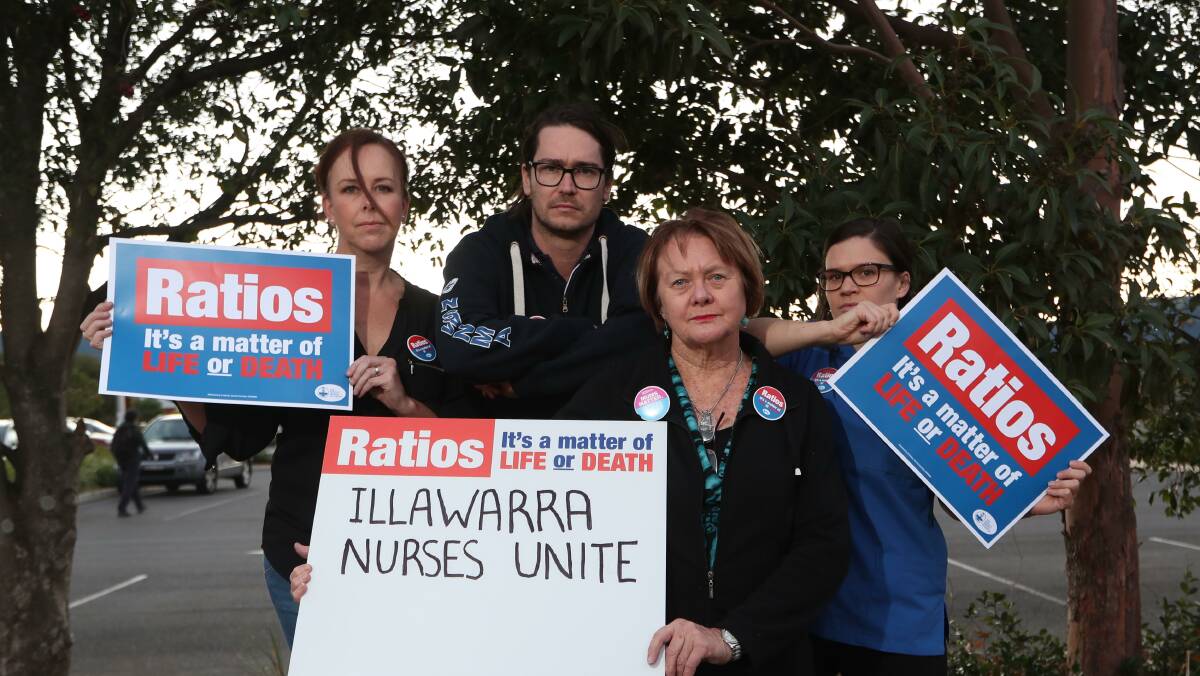
Illawarra nurses are calling for equal nurse-to-patient ratios to stop the disparity in care at hospitals across the region.
Subscribe now for unlimited access.
$0/
(min cost $0)
or signup to continue reading
NSW Nurses and Midwives Association region organiser Alistair Ball said having mandated ratios at all of the state’s public hospitals, would be far more equitable than NSW Health’s current staffing formula.
“Under the current ‘nursing hours per patient day’ (NHPPD) measure, staffing levels vary from hospital to hospital,” he said.
“For instance, if you’re a patient at Wollongong Hospital you are entitled to six nursing hours per day – whereas a patient undergoing the same procedure at Shellharbour Hospital would be entitled to five nursing hours per day.
“With set ratios statewide, it would mean that regardless of where you happen to live, and what hospital you’re at, everyone gets the same level of nursing care. It’s about having a transparent staffing model.”
Mr Ball said in 2011 the NSWNMA successfully campaigned for mandatory ratios for many units of metropolitan hospitals. However the NSW Government had since not extended those ratios to rural or regional hospitals or into specialty areas like emergency departments.
The union officially launched its 2018 public awareness campaign, ‘Ratios: It’s a matter of life or death’ this week.
“We want to see ratios of one nurse to four patients in general medical and surgical wards across the state,” Mr Ball said. “We also want to bring in ratios of one to three in emergency departments and paediatric units and ratios of one to one in intensive care units.”
Illawarra nurses started campaigning last month, attending Wollongong’s Eat Street markets on April 26 to highlight to the community the pressures they’re under as a result of understaffing.
“The lack of ratios means staff have increased workloads, which has a direct impact on their ability to deliver the care they want to deliver,” Mr Ball said.
“It’s being felt across the district but particularly in emergency departments at Wollongong and Shoalhaven hospitals which are seeing increased presentations, but no increase in staffing to reflect that.”
However Illawarra Shoalhaven Local Health District’s acting executive director of nursing and midwifery Karen Tuqiri said the “complexity of a hospital and its patients” decided staffing levels, not its location.
“NSW Health does not use ratios, instead a more flexible set of principles and rules in the (state award) identify how nursing staff are provided to wards,” she said.
Ms Tuqiri said the method determined the minimum number of staff needed to deliver safe and effective care.
“Additional nurses can be provided where ward activity or patient care needs are unusually high and more staff are needed,” she said.
“This means that, rather than just patient numbers, other important factors that affect safe staffing can also be included in determining the correct staffing numbers.
“In this way the right number of nurses is in place to provide patients with the right care at the right time.”
Ms Tuqiri said in 2017/18, the health district would spend more than $250 million employing nurses and midwives across its various sites and services. That included 100 new nurse graduates who joined the district earlier this year.
But NSWNMA general secretary Brett Holmes said the NSW government could not continue to ignore the link between nurse staffing levels and improved patient outcomes.
“We know ratios save lives. Research has shown that every additional patient per nurse can increase the likelihood of an inpatient dying by seven per cent,” Mr Holmes said.
“The state government must put this system in place to safeguard the future of our public health system.
“… If mandated staffing systems are not in place, we risk losing valuable trained nursing and midwifery staff to stress and burnout.”
Mr Holmes said Victoria and Queensland had made nurse-to-patient ratios law; it was now the NSW government’s turn to commit.

